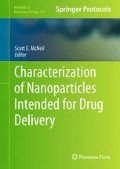Abstract
Certain nanoparticles have been shown to accumulate within lysosome and hence may cause lysosomal pathologies such as phospholipidosis, lysosomal overload, and autophagy. This chapter describes a method for evaluation of lysosomal activity in porcine kidney cells (LLC-PK1) after exposure to nanoparticles. This method uses the accumulation of a cationic fluorescent dye (LysoTracker Red) in acidic cellular compartments as an indicator of total lysosome content. The lysotracker signal is normalized to the signal from a thiol-reactive dye which is proportional to the total number of viable cells.
Access this chapter
Tax calculation will be finalised at checkout
Purchases are for personal use only
References
Schneider, P., Korolenko, T.A., and Busch, U. (1997). A review of drug-induced lysosomal disorders of the liver in man and laboratory animals. Microsc Res Tech. 36, 253–75.
Moore, M.N. (2006). Do nanoparticles present ecotoxicological risks for the health of the aquatic environment? Environ Int. 32, 967–76.
Zabirnyk, O., Yezhelyev, M., and Seleverstov, O. (2007). Nanoparticles as a novel class of autophagy activators. Autophagy 3, 278–81.
Monteith, D.K., Morgan, R.E., Halstead, B. (2006). In vitro assays and biomarkers for drug-induced phospholipidosis. Expert Opin Drug Metab Toxicol. 2, 687–96.
Klionsky, D.J., Cuervo, A.M., Seglen, P.O. (2007). Methods for monitoring autophagy from yeast to human. Autophagy 3, 181–206.
Rodriguez-Enriquez, S., Kim, I., Currin, R.T., and Lemasters, J.J. (2006). Tracker dyes to probe mitochondrial autophagy (mitophagy) in rat hepatocytes. Autophagy 2, 39–46.
Acknowledgments
This project has been funded in whole or in part by federal funds from the National Cancer Institute, National Institutes of Health, under contract N01-CO-12400. The content of this publication does not necessarily reflect the views or policies of the Department of Health and Human Services, nor does the mention of trade names, commercial products, or organizations imply endorsement by the U.S. Government.
Author information
Authors and Affiliations
Editor information
Editors and Affiliations
Rights and permissions
Copyright information
© 2011 Springer Science+Business Media, LLC
About this protocol
Cite this protocol
Neun, B.W., Stern, S.T. (2011). Monitoring Lysosomal Activity in Nanoparticle-Treated Cells. In: McNeil, S. (eds) Characterization of Nanoparticles Intended for Drug Delivery. Methods in Molecular Biology, vol 697. Humana Press. https://doi.org/10.1007/978-1-60327-198-1_22
Download citation
DOI: https://doi.org/10.1007/978-1-60327-198-1_22
Published:
Publisher Name: Humana Press
Print ISBN: 978-1-60327-197-4
Online ISBN: 978-1-60327-198-1
eBook Packages: Springer Protocols

